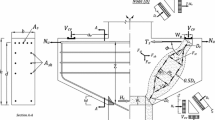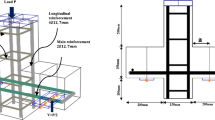Abstract
Currently, concretes of higher compressive strengths have been produced and increasingly used by designers and contractors for both reinforced and prestressed concrete construction. The design of concrete corbels using the strut-and-tie model considers two failure modes: failure by crushing concrete in the strut and by yielding of the main steel reinforcement. To consider the failure by diagonal tension, a third equation is included in the truss plastic model proposed by Rogowsky and MacGregor. To use the truss plastic model, an efficiency factor is applied to reduce the effective concrete strength. An efficiency factor is proposed in this paper for high performance concrete. The proposed model using the new efficiency factor gives an improved correlation with experimental data. Based on the test results reported from literature review, the design method proposed by AFREM for high stregth concrete corbels is modified in this paper to make design of high strength concrete corbels more reasonable. The comparison with experimental data shows that the modified AFREM model predicts fairly well the shear capacity of the corbels.
Résumé
À ce jour, les bétons de hautes performances connaissent de multiples utilisations par des concepteurs et des constructeurs pour des éléments en béton armé et précontraints. Le dimensionnent de consoles courtes selon le modèle de bielle-et-tirant prend en considération deux types de rupture: celle par palstifiction des aciers de flexion et celle par écrasement de la bielle du béton. Pour tenir compte de la rupture diagonale des consoles, une troisième équation a été introduite dans le modèle de treillis plastique par Rogowsky et MacGregor. Pour ce modèle, nous proposons un nouveau coefficient d'efficacité pour le béton de hautes performances qui permet une meilleure corrélation avec les données expérimentales. Sur la base de résultats des essais trouvés dans la littérature, le modèle de dimensionnement des consoles en béton de hautes performances proposé par l'AFREM a été modifié afin de prédire la capacité en cisaillement des consoles.
Similar content being viewed by others
References
Rogowsky, D. M. and MacGregor, J. G., ‘Design of reinforced concrete deep beams’,Concrete International 3 (1986) 49–58.
Foster, R.E., ‘Performance of high-strength concrete corbels’,ACI Structural Journal 93 (5) (1996) 555–563.
Regles B.A.E.L 91, ‘Règles techniques de conception et de calcul des ouvrages et constructions en béton armé suivant la méthode des états limites’ (Ed. Eyrolles, 1993).
Schafer, K., ‘Design and detailing of structural concrete using strut-and-tie models’,The Structural Engineer, Proceeding69 (6) (1991) 825–831.
Foster, S.J., ‘Structural Behavior of Reinforced Concrete Beams’, PhD dissertation, School of Engineering, University of South Wales, Aug. 1992.
Siao, W. B., ‘Shear strength of short reinforced concrete walls, corbels, and deep beams’,ACI Structural Journal 91 (2) (1994) 123–131.
Siao, W. B., ‘Strut-and-tie model for shear behavior in deep beams and pile caps failing in diagonal splitting’,Ibid. 90 (5) (1994) 356–363.
Remel, G. and Koning, G., ‘The tensile strength of high performance concrete and its effect on the shear strength of longitudinally reinforced concrete members’, in ‘Utilization of High-Strength/Performance Concrete’, Symposium, Lillehammer, 1993, 269–276.
Marti, D., ‘Basic tools of reinforced concrete design’,ACI Structural Journal 82 (1) (1995) 46–56.
Ramirez, J. and Breen, J., ‘Evaluation of a modified truss model approach for beams in sheart’,Ibid. 88 (5) (1991) 562–571.
Rogowsky, D.M., ‘Shear Strength of Deep Reinforced Concrete Continuous Beams’, Structural Engineering Report No. 110, University of Albert (1983), 178 p.
Yun, Y. M. and Ramirez, J., ‘Strength of struts and nodes in strut-tie model’,ASCE Journal Structure 122 (1) (1996) 20–29.
Fouré, B., ‘Dimensionnement des Consoles Courtes’, Rapport Interne (CEBTP 1995).
Vecchio, F. J. and Collins, M.P., ‘High strength concrete elements subjected to shear’,ACI Structural Journal 91 (4) (1994) 423–433.
Rangan, B. V. and Gupta, A., ‘High strength concrete structural walls under inplane vertical and horizontal loads’, in ‘Utilization of High-Strength/Performance Concrete’, Symposium, Lillehammer, 1993, 177–183.
AFREM, ‘Connaissance et Utilisation des BHP’, Rapport final, Mai, 1995.
Chen, Y. I. and Lin I. J., ‘Shear transfer across a crack in reinforced high-strength concrete’, Proceedings of the Second East Asia-Pacific Conference on Structural, Engineering and Construction, Chiang, Main, Thailand, Jan. 1989, 505–510.
Author information
Authors and Affiliations
Additional information
Editorial Note M. Saafi is a RILEM Student Member.
Rights and permissions
About this article
Cite this article
Saafi, M., Toutanji, H. Design of high performance concrete corbels. Mat. Struct. 31, 616–622 (1998). https://doi.org/10.1007/BF02480612
Received:
Accepted:
Published:
Issue Date:
DOI: https://doi.org/10.1007/BF02480612




